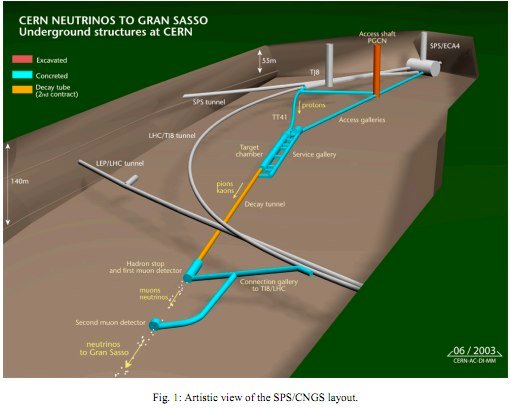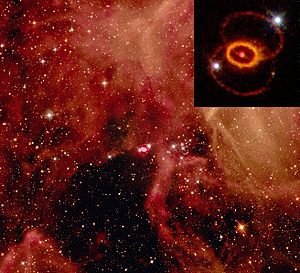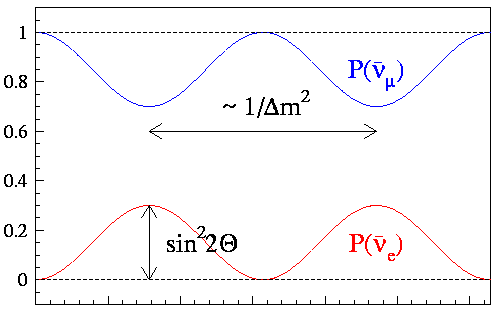Can neutrinos be faster than the speed of light? Taking a Look Inside!
Neutrinos are fundamental particles in the structure of the universe, but paradoxically they are the least understood. These subatomic particles are produced during the decay of radioactive elements. They are the elementary particles of lower mass (one-millionth of the mass of a hydrogen atom) and do not have an electric charge.
Although its existence was predicted by the physicist Wolfgang Pauli in 1931, for the laws of conservation of energy and the moment in certain radioactive decays to be fulfilled, they owe their name to the Italian physicist Enrico Fermi, who developed the theory of radioactive decay in 1934 , including the particle of Pauli, which he named a neutrino. Of all the high-energy particles, weakly interacting neutrinos are the only ones capable of giving clues about what happens in very high-energy processes and of providing astronomical data about the confines of the universe. Neutrinos travel essentially at the speed of light and are not affected by magnetic fields, only by the subatomic or weak nuclear force that is much smaller range than the electromagnetic forces, which act eg. between the electrons, and by the gravitational force that is the weakest of all the forces. Therefore, they are able to travel enormous distances in matter without being affected by it. This elusive particle could only be detected in the laboratory in 1956, and F. Reines was awarded the Nobel Prize in 1995 as a result of this discovery.

How do neutrinos behave?
The neutrinos behave differently depending on the charged particle to which they are associated, so they are classified into three classes or flavors: the electron neutrino associated with: The electron, the muon associated with the muon and the tau, associated with The tau particle. The verification of the neutrino mass involved the possibility of transformations of one type of neutrino in another, a phenomenon known as oscillation of neutrinos.
The neutrinos that are in the current universe were originated around 15 billion years ago, after the Big Bang. Since then the universe is expanding and cooling, and the huge amount of existing neutrinos from the so-called cosmic radiation background whose temperature is 1.9 degrees Kelvin, ie -271.2 degrees Celsius. The Sun is the most important source of production of neutrinos, which are produced inside by radioactive decay and escape also through the Earth. Other neutrinos are constantly produced in nuclear power plants, particle accelerators, during atmospheric phenomena, or birth and death of stars, as well as in supernova explosions.

In September 2011, the OPERA collaboration, an investigation carried out between laboratories at CERN, in Switzerland, and the other at Monte Sasso, Italy, announced that the development of measurements of the latest increase in the speed of a certain class of neutrinos they take superluminal values. That is, neutrinos that travel greater than light speed are detected, which is in contradiction with the theory of relativity. In November 2011, due to adverse policies, new experiments were announced to verify or refute these results.

Finally, on June 8, 2012, the European Laboratory for Particle Physics (CERN) announced that recent experiments showed that the velocity of neutrinos was NO greater than the speed of light, ruling out the possibility of superluminal neutrinos, as had suggested following the OPERA experiment conducted during the year 2011.
Due to its nature, the detection of neutrinos is very difficult. The first test was carried out in 1967 using a detector that used chlorine, and that could capture neutrinos in a radioactive process. The detector had a tank with about 400 thousand liters of fluid buried in a mine to protect it from unwanted effects of cosmic background radiation. However, the results of the measurements yielded a result of one-third of the flux of expected neutrinos, which raised many doubts, so that they began to develop other detection systems. The most famous was the super KamioKande, built in 1987 at the Kamioka mine in Japan, which measured the radiation produced when neutrinos collided with electrons in an aqueous medium, giving rise to the so-called Cherenkov radiation, which was captured by detectors in the walls of a container of 40 m in diameter and 40 in height. With this device, it was possible to detect the neutrinos emitted in the 1987A supernova explosion, and also solar neutrinos that confirmed the results obtained using the chlorine detector. His most spectacular achievement is having been able to measure (or limit the value of) the mass of the neutrino in 1998, which led to the awarding of the Nobel Prize in Physics to Takaaki Kajita in 2015.

Kajita has the oscillation of the neutrinos in the Super Kamiokande, and can oscillate between two different states or types. McDonald worked at the Neutrinos Observatory in Sudbury, Ontario, Canada, more than two million meters underground, in an old nickel mine, and there he found the neutrinos of the roots of the Sun, it did not disappear but moved between two different types, similar to what was detected by Kajita. This discovery was crucial to demonstrate that neutrinos possess mass.

THANKS FOR YOUR TIME
You can always find quality content @rickyxp
For more Information about this subject you can visit:
- https://en.wikipedia.org/wiki/Neutrino
- https://en.oxforddictionaries.com/definition/neutrino
- Fundamentals of Neutrino Physics and Astrophysics, Carlo Giunti
Congratulations @rickyxp! You have completed some achievement on Steemit and have been rewarded with new badge(s) :
Click on any badge to view your own Board of Honor on SteemitBoard.
For more information about SteemitBoard, click here
If you no longer want to receive notifications, reply to this comment with the word
STOPI think you have made a mistake, it isn't 2000km underground, it is 2 km or 2000m underground
Yes, sorry for that I'll fix it asap